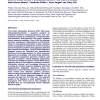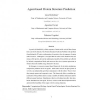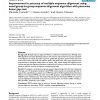372 search results - page 34 / 75 » Fast Protein Structure Alignment |
BMCBI
2004
13 years 7 months ago
2004
Background: The wealth of information on protein structure has led to a variety of statistical analyses of the role played by individual amino acid types in the protein fold. In p...
NAR
1998
13 years 7 months ago
1998
The Protein Information Resource (PIR; http://wwwnbrf.georgetown.edu/pir/ ) supports research on molecular evolution, functional genomics, and computational biology by maintaining...
MAGS
2007
13 years 7 months ago
2007
A protein is identified by a finite sequence of amino acids, each of them chosen from a set of 20 elements. The Protein Structure Prediction Problem is the problem of predicting...
BMCBI
2008
13 years 7 months ago
2008
Background: Nonnegative matrix factorization (NMF) is a feature extraction method that has the property of intuitive part-based representation of the original features. This uniqu...
BMCBI
2006
13 years 7 months ago
2006
Background: Multiple sequence alignment (MSA) is a useful tool in bioinformatics. Although many MSA algorithms have been developed, there is still room for improvement in accuracy...



